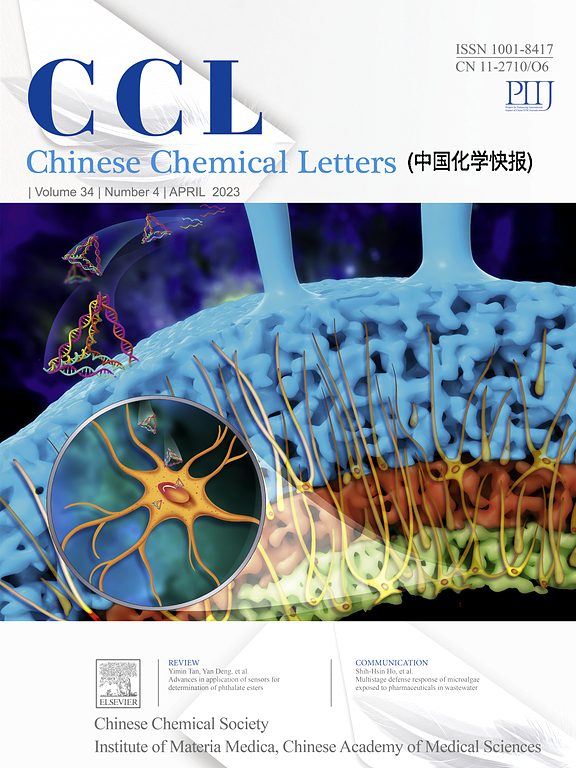全聚合物太阳能电池用具有1000 nm吸光度边缘的氟化熔融偶氮苯硼基聚合物受体
IF 9.4
1区 化学
Q1 CHEMISTRY, MULTIDISCIPLINARY
引用次数: 0
摘要
氟化熔融偶氮苯硼(FBAz)是全聚合物太阳能电池(all- PSC)中用于聚合物电子受体的新型缺电子构件。B←N桥接单元具有固定的结构和较低的LUMO/HOMO能量。通过FBAz与吲哚二噻吩(IDT)共聚,合成了三种不同氟取代位置的聚合物受体材料P2f、P3f和P5f,研究了氟化形式对全聚合物太阳能电池性能的影响。FBAz单元只需三步合成,便于直接生产聚合物受体P2f、P3f和P5f。这些受体在可见光到近红外500-1000 nm范围内具有很强的光吸收能力,具有合适的LUMO/HOMO能级-3.99/-5.66 eV,与广泛使用的聚合物供体聚[(乙基己基噻吩)-苯并二噻吩-(乙基己基)-噻吩](PTB7-Th)的LUMO/HOMO能级(ELUMO/HOMO = -3.59/-5.20 eV)非常互补。以PTB7-Th为电子给体,P3f为电子受体的全聚合物太阳能电池(all-PSCs)具有最高的功率转换效率(PCE),为2.70 %。当加入PC61 BM作为第三组分时,器件效率可达5.36%。这些初步结果表明,FBAz是一种很有前途的强电子受体,可用于发展n型聚合物半导体,特别是在有机光伏(opv)中。据我们所知,这是第一个证明N=N双键作为受体材料的独特光伏特性的例子。本文章由计算机程序翻译,如有差异,请以英文原文为准。

Fluorinated fused azobenzene boron-based polymer acceptors with 1000 nm absorbance edges for all-polymer solar cells
Fluorinated fused azobenzene boron (FBAz) is a novel electron-deficient building block for polymer electron acceptors in all-polymer solar cells (all- PSC). The B←N bridging units impart a fixed configuration and low-lying LUMO/HOMO energy. Three polymer acceptor materials (P2f, P3f and P5f) with different fluorine substitution positions by copolymerizing FBAz with indacenodithiophene (IDT), are synthesized and investigated to study the influence of fluorinated forms on the all-polymer solar cell performance. The FBAz units are synthesized in just three steps, facilitating the straightforward production of polymer acceptors P2f, P3f, and P5f. These acceptors exhibit strong light absorption in the visible to near-infrared range of 500–1000 nm and possess suitable LUMO/HOMO energy levels of -3.99/-5.66 eV which are very complementary to that (ELUMO/HOMO = -3.59/-5.20 eV) of the widely-used polymer donor poly[(ethylhexylthiophenyl)-benzodithiophene-(ethylhexyl)-thienothiophene] (PTB7-Th). All-polymer solar cells (all-PSCs) with PTB7-Th as electron donor and P3f as electron acceptor exhibits highest power conversion efficiencies (PCE) 2.70 %. When PC61 BM is added as the third component, the device efficiency can reach 5.36%. These preliminary results indicate that FBAz is a promising strong electron acceptor for the development of n-type polymer semiconductors, especially in organic photovoltaics (OPVs). To the best of our knowledge, this is the first example demonstrating the unique photovoltaic properties of the N=N double bond as an acceptor material.
求助全文
通过发布文献求助,成功后即可免费获取论文全文。
去求助
来源期刊

Chinese Chemical Letters
化学-化学综合
CiteScore
14.10
自引率
15.40%
发文量
8969
审稿时长
1.6 months
期刊介绍:
Chinese Chemical Letters (CCL) (ISSN 1001-8417) was founded in July 1990. The journal publishes preliminary accounts in the whole field of chemistry, including inorganic chemistry, organic chemistry, analytical chemistry, physical chemistry, polymer chemistry, applied chemistry, etc.Chinese Chemical Letters does not accept articles previously published or scheduled to be published. To verify originality, your article may be checked by the originality detection service CrossCheck.
 求助内容:
求助内容: 应助结果提醒方式:
应助结果提醒方式:


